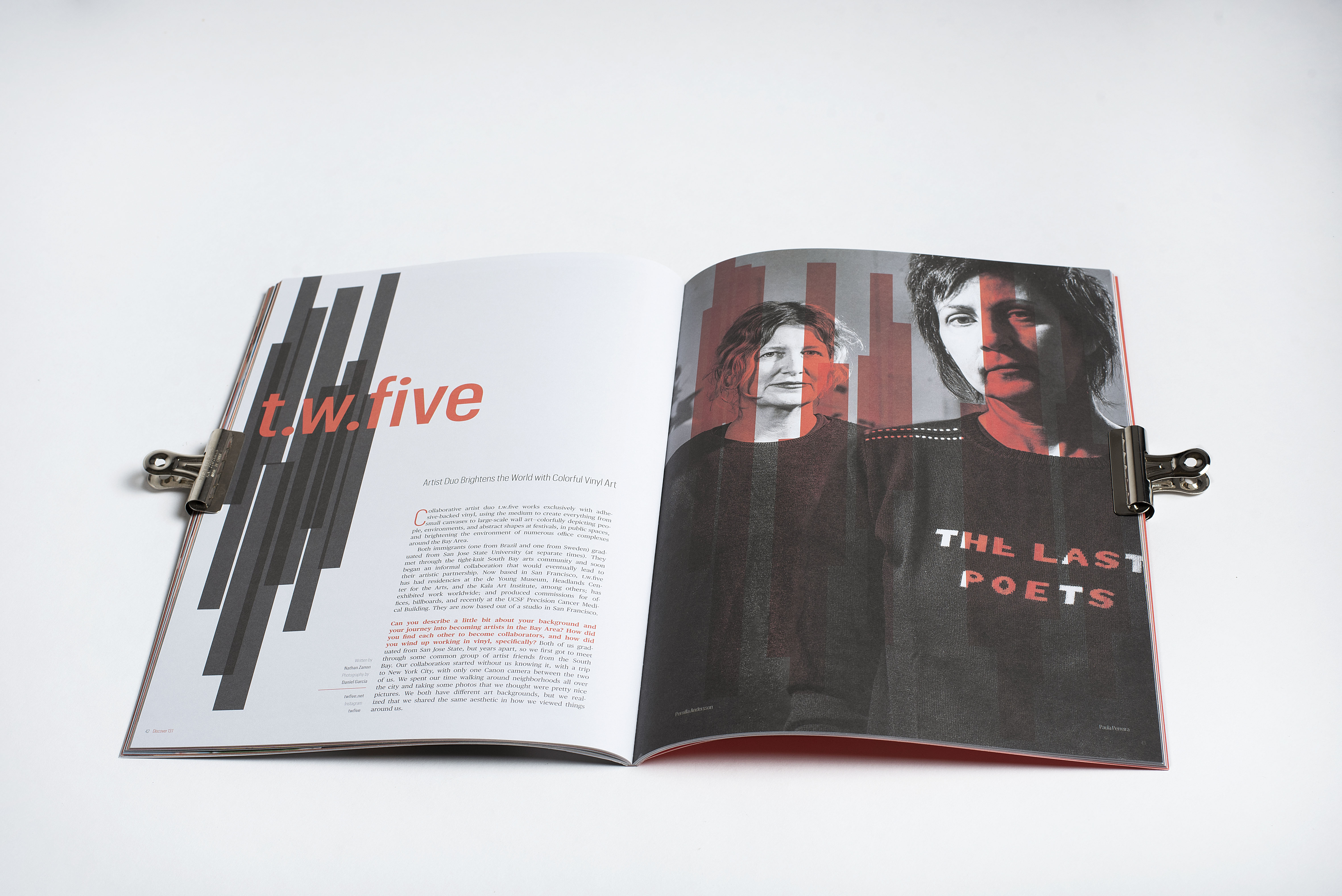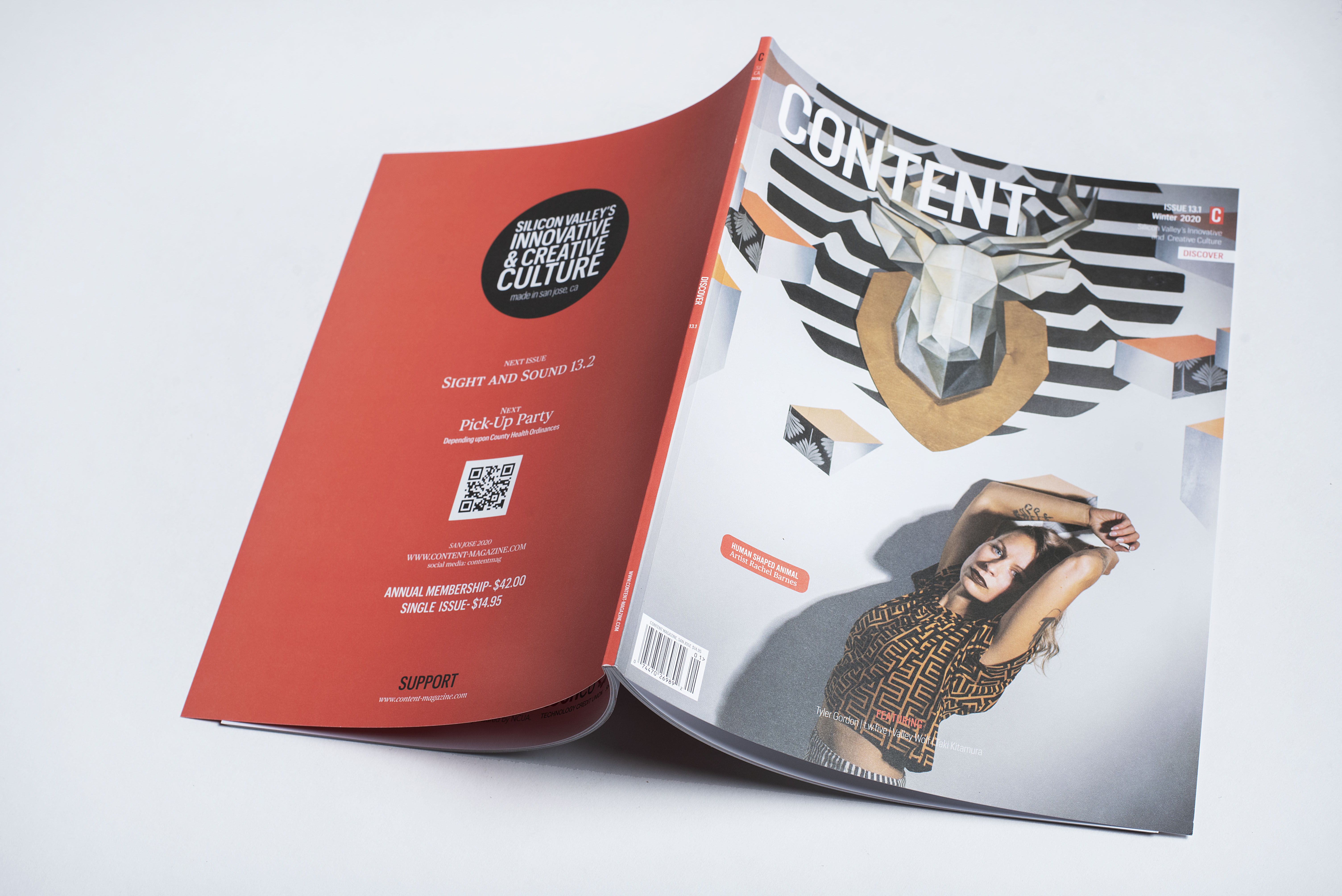Collaborative artist duo t.w.five works exclusively with adhesive-backed vinyl, using the medium to create everything from small canvases to large-scale wall art—colorfully depicting people, environments, and abstract shapes at festivals, in public spaces, and brightening the environment of numerous office complexes around the Bay Area.
Both immigrants (one from Brazil and one from Sweden) graduated from San Jose State University (at separate times). They met through the tight-knit South Bay arts community and soon began an informal collaboration that would eventually lead to their artistic partnership. Now based in San Francisco, t.w.five has had residencies at the de Young Museum, Headlands Center for the Arts, and the Kala Art Institute, among others; has exhibited work worldwide; and produced commissions for offices, billboards, and recently at the UCSF Precision Cancer Medical Building. They are now based out of a studio in San Francisco.
Can you describe a little bit about your background and your journey into becoming artists in the Bay Area? How did you find each other to become collaborators, and how did you wind up working in vinyl, specifically? Both of us graduated from San Jose State, but years apart, so we first got to meet through some common group of artist friends from the South Bay. Our collaboration started without us knowing it, with a trip to New York City, with only one Canon camera between the two of us. We spent our time walking around neighborhoods all over the city and taking some photos that we thought were pretty nice pictures. We both have different art backgrounds, but we realized that we shared the same aesthetic in how we viewed things
around us.

When arriving back in San Francisco, one of us needed to use some of the photos from our New York trip for an upcoming show. From that, the idea of us collaborating came up. But [it] was alien to both of us, since we both have always created art in solitude. We were also aware that our personal art styles are very different from one another, as well as our material choices, one of us being photographer/screen.printer of urban culture, [the other a] painter that practiced expressive, mostly figurative/landscape paintings. Needless to say, we decided to give the collaboration a go, and it was the first time we introduced adhesive rolls of vinyl as our primary material.
Who and what are some of your biggest influences and inspirations? That’s the thing. Since we both came from different backgrounds, we also have different artists that we liked and shared between us. We will say, anything that came out from the Bay Area figurative movement from the ’50s and ’60s—David Park, Richard Diebenkorn, Elmer Bichoff, Nathan Olivera, and Joan Brown, also a HUGE inspiration from Andy Warhol that we can never get enough from, and the Bauhaus movement of combining craft with art. We also love looking at architecture, design, street art, Pop Art, Brazilian concrete art and poetry, Japanese contemporary art, Cy Twombly, photography, music—lots of it—film, and filmmakers like Wes Anderson, Neill Blomkamp, Lukas Moodysson, sci-fi…
What are some of your favorite pieces you’ve created or experiences you’ve had creating and exhibiting large-scale art works? Tough question—it is hard to pick out favorites. But we have a special love for a 44-foot piece we did for the Headlands Center for the Arts benefit auction in 2016. The piece is called it’s all fun at 2:15 am and was based on the dynamics and a moment being in an art studio. We used multiple images from Warhol factory, which we made into our own composition and colors. This piece is now part of the Facebook collection.
We love so many. Making each one is a unique experience that we dive into completely.
We finished a six-floor commission at UCSF’s new cancer wing at Mission Bay. That commission was a year and half of meetings with the board, the architects, and designers. It was a lot of learning. Every single step of the way had to be looked at and approved because we were dealing with a sensitive audience: the patients. It was a beautiful journey for us.
You’ve also been commissioned to create works for some of the tech giants of the area. How did these come to be, and what were your experiences like? Yes, we have done artworks for Google, Facebook, GoDaddy, Checkr. The GoDaddy piece was the only one that we did at the company and straight on the wall. All the others, we did the majority of the work in panels at the studio and then installed at the headquarters and did some add-on there. That is the part we love, because we get to interact with the workers and hear their opinions and feedback—and be part of their culture, too.
Usually, once [companies] contact us, we go to meetings to exchange ideas about what they envision. We always try to bring to the table our ideas that we can see it incorporating into what they want. With some, we have absolutely had freedom to do what we wanted, and those are super fun.
How would you describe the way you conceive of and create your pieces? How does your collaboration work? Do either of you focus more on specific elements of the creation process? The ideas come from things we are interested in or something we see that inspires us. We both bring our ideas to the studio and show them to one another and feed on each other’s ideas and inspirations.
Once we are set on the subject, we start to look for images on the internet, read and research a lot about it. After we find the images, we work on them a bit on Photoshop—adding colors or subtracting things in the image we don’t want, etc. Then, if the work is big, we project [onto a surface] just to get the basic outline of things, then turn off the projector and improvise everything. We do everything in vinyl, and it is all hand-cut. The only tools we use are an Exacto knife, scissors, and ruler.
We work on different parts of the artwork together and then we switch. When we step back to look at the work, we always like and dislike the same things. It’s incredible how our minds work together in such harmony.
How has the time of COVID-19 and shelter-in-place changed your process or perspective as artists, if at all? First, it was a bit of adjustment, but then we both turned to our studio as much as we could and started to work all the time. It was actually what kept us sane to navigate through these new, different times. All our exhibitions and commissions got either canceled or postponed. So, we had to figure out other ways to promote our work or apply for new projects. But it turned out that we found a lot of inspiration and ways to communicate with fellow artists or our collectors via Zoom.
Article originally appeared in Issue 13.1 Discover (Print SOLD OUT)

